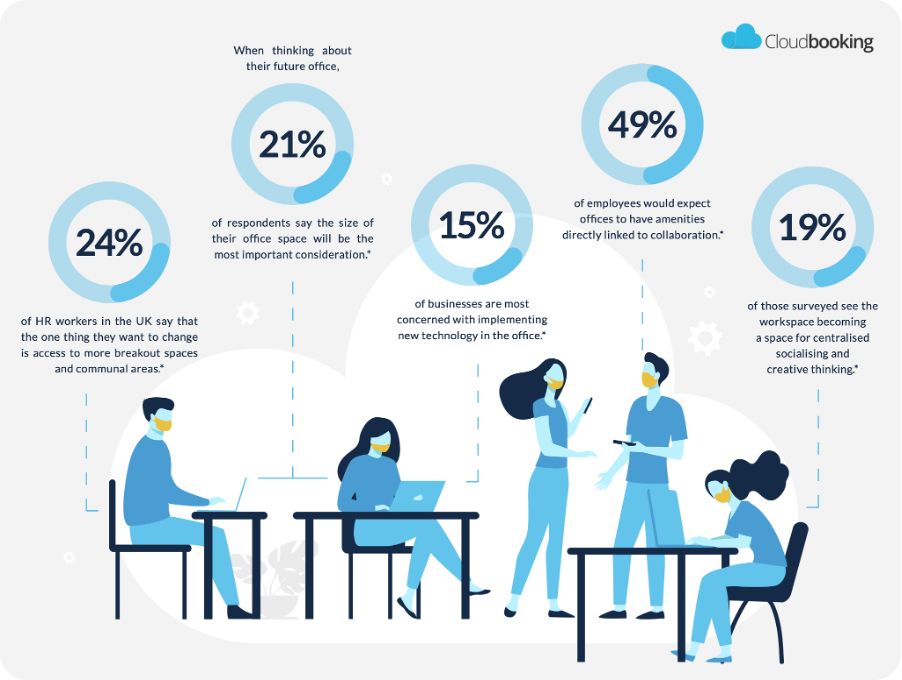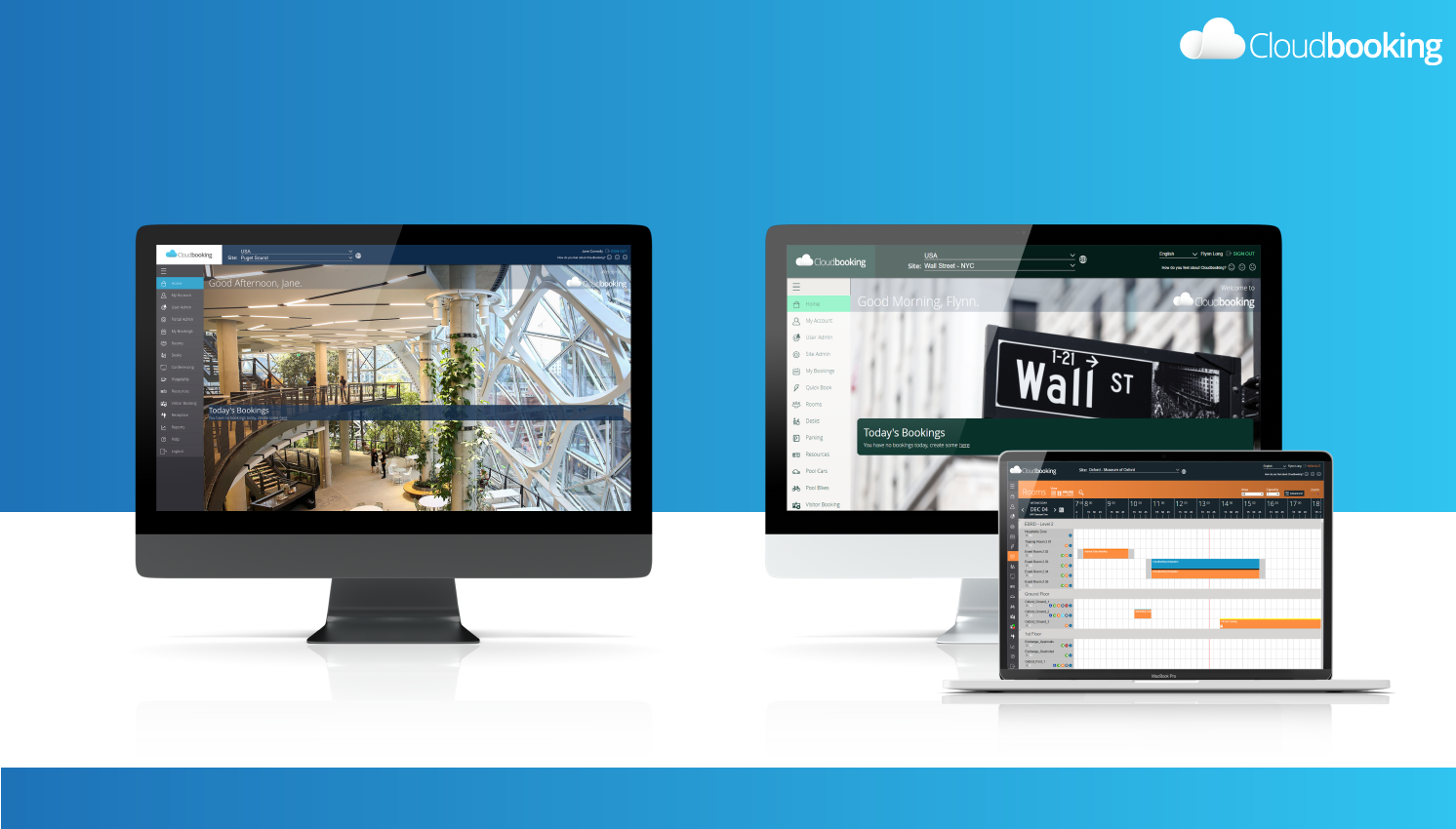
Navigating the COVID-19 pandemic and its aftermath will be one of the biggest business shifts of our time.
For the most part, companies have done a great job pulling out all the stops to keep up with ever-changing restrictions and their employees’ needs.
Get a free demo
Enquire about a no-obligation demo today and get an exclusive hybrid working research paper — for free. Created in partnership with YouGov, this invaluable guide provides essential insights into developing your own effective hybrid strategy. Click below.
As employees begin to return to work, businesses can continue to turn the challenges created by COVID-19 into areas of opportunity. This will not only lead to businesses being able to reduce costs and increase their productivity but will also allow them to tap into the needs of their employees.
Our experts have compiled a list of the top five opportunities for businesses to improve their workplace in their return-to-work transition.
1. Set Return-to-Work Guidelines
As businesses work towards reopening their workspaces, they must remain mindful of changing advice and restrictions. All employers need to plan for any return to the workplace in a way that cares for their people and safeguards their health and wellbeing.
COVID-19 Challenge: Businesses need to set return-to-work guidelines for a staged return to the workplace solution after COVID-19 across their different departments.
Opportunity: Successful businesses thrive on motivated workforces. Keeping staff informed of what your business is doing — whether it is good or bad news for individuals — it will help them to plan and make their own decisions, giving them some degree of security in these uncertain times.
Setting clear return-to-work guidelines will go a long way in helping ease the transition and make sure staff coming back to work are reassured that their safety and wellbeing are a priority. It allows businesses to secure their workplace by implementing a clear procedure for contact tracing. By allowing employees back to the office in phases based on necessity and risk, organizations can easily protect those most vulnerable and better isolate any COVID-19 outbreaks should they arise.
Focusing on building confidence and care across employees, customers, partners, suppliers and stakeholders. The companies that build trust through their transition will be the winners coming out of this crisis.
2. Understand How Your Employees Will Use the Workplace Post COVID-19
The pandemic has had far-reaching effects on the way people work and what motivates them. Now more than ever employees want the idea of the “traditional” workplace to be re-imagined to better suit their needs.
COVID-19 Challenge: Businesses are now facing potential issues with regards to workspace inefficiencies. With the majority of people wanting to move to a hybrid work environment, where they work from home some of the time, organizations are facing the costs of unused office space and resources.
Opportunity: As they plan their return to work, businesses have the chance to question their employees on how they plan to make use of the workplace. Understanding who needs to be in the space and how employees are motivated will be core to rethinking the need for the workspace and its design.
Businesses that open up the dialogue with their employees seize the opportunity to fundamentally redesign the office to facilitate hybrid working and meet employees’ needs. This will help businesses increase their employees’ productivity by ensuring they have all the resources they need. It will also boost employee morale by making sure their voices are heard.
“We’ve long promoted flexible working…We want our people to feel trusted and empowered. These changes are in direct response to soundings from our people, who’ve said they value a mix of working from home and in the office. We want to help enshrine new working patterns so they outlast the pandemic.”
– Kevin Ellis, Chairman and Senior Partner at PwC
3. Consider Office Space
We all have ideas about what a typical office looks and feels like. However, the amount of office space needed by businesses is on track to be very different to pre-pandemic usage.
COVID-19 Challenge: Although offices have changed in some ways during the past decade, they may no longer be fit for purpose or cost-effective. As a result, office space may need to be entirely re-thought and transformed to suit a post–COVID-19 world.
Opportunity: Organizations now have the opportunity to create workspaces specifically designed to support the kinds of interactions that cannot happen remotely. Businesses should consider flexible, shared and co-working office spaces.
As greater portions of the workforce embrace working from home, businesses can reduce individual workspaces within the office and increase flexible spaces for purpose-driven collaboration. This will help to reduce costs incurred by having unused office space.
“Before the pandemic, there was already ample opportunity to rethink and repurpose real estate footprints to match the evolving needs of employees. But now, it’s an imperative.”
– VergeSense Think Tank Report
4. Plan Your Office Layout
Every business reopening after lockdown has to reconfigure its workspace layout to maintain social distancing guidelines.
COVID-19 Challenge: Organizations need to plan their office layout to keep their employees safe and maximize productivity simultaneously.
Opportunity: Businesses now have the chance to make their office layout even better than it was before the pandemic. A hybrid office design that features big working rooms, break-out spaces and creative hubs will help businesses to re-channel the office purpose from a place of individual work to one of collaboration. This will uplift team morale and increase productivity and staff happiness.
To ensure employee safety, having touchless and hands-free areas within the office design will be key. The focus will be on limiting contact with high-touch surfaces, such as lifts, receptions and shared spaces, by implementing hands-free alternatives like QR codes and motion sensors.

5. Implement a Cloud-Based Facilities Management Software
In the workspace of the future, technology will play a central role in enabling employees to return to office buildings and to work safely and productively.
COVID-19 Challenge: To stay ahead of the curve post-pandemic, companies will need to implement new technological processes to ensure the safety of their employees and facilitate hybrid working.
Opportunity: Workplace innovation is a truly effective way for businesses to enhance their competitive edge and support their employee’s return to work. Businesses should seize the opportunity to invest in cloud-based facilities management software.
As the first point of entry in all buildings, advanced reception software will play a critical role in screening for health, facilitating authorized entry and enabling social distancing, while desk booking and room booking technology will enable businesses to successfully manage their hybrid workforce.
The deployment of new workplace management software will create a culture where staff are fully engaged and supported to reach their potential. This ultimately makes a profitable, efficient and responsive business.
Seize the opportunities your organization has to improve its workspace technology during its return-to-work transition. Contact us now for a no-obligation product demo


